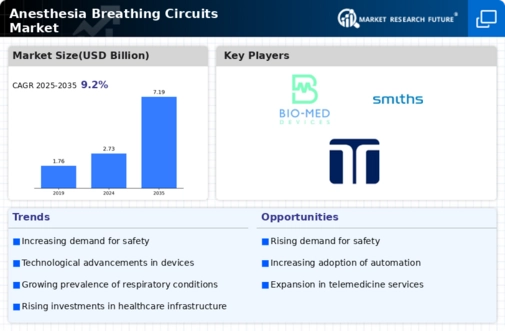Market Trends
Key Emerging Trends in the Anesthesia Breathing Circuits Market
The Anesthesia Breathing Circuits Market has witnessed significant trends and developments demonstrating the changing nature of healthcare as well as anesthesia delivery systems. Among them is a rising preference for disposable anesthesia breathing circuits. Disposable circuits are favored by medical practitioners, facilities and institutions due to their cost effectiveness, minimal risk of infection through cross contamination and convenience in use. This transition towards disposable circuits complies with growing industry attention on infection control and patient safety.
Moreover, market movements are being influenced by technological advancements. Integration of innovative materials and designs into anesthesia breathing circuits has enhanced their performance levels as well as efficiency. Manufacturers are focusing on developing circuits that offer best ventilation, minimize resistance and guarantee improved patient outcomes. These technological developments significantly contribute to bettering anesthesia administration overall whose outcome is a positive market direction.
Another major trend within the Anesthesia Breathing Circuits Market today is the increased adoption of modular breathing circuits. Many times, health care providers have a need for modified versions of systems which can suit individual patients’ needs; this kind of flexibility cannot be achieved with other types of devices available on this market. Its adaptability enhances patient comfort while it also makes anesthesia process more efficient at its delivery level as well. A modular approach demonstrates an industry’s commitment towards customization as well as individualized attention to patients.
There is an increase in demand for eco-friendly and sustainable anesthesia breathing circuits in the market since manufacturers have gone green towards environmental conservation. The world over companies producing these products have turned to greener materials options for making these items hence reducing the impact they would have on environment when disposed recklessly. Within healthcare sectors at large however there has been emphasis on going green such that attempts are made towards having practices that promote environmentally friendly approaches including addressing issues around carbon emissions.
Furthermore, the Anesthesia Breathing Circuits Market is affected by surging cases of chronic respiratory ailments coupled with a rapidly growing elderly population. With rising prevalence in respiratory conditions, the demand for better anesthesia platforms increases. On the other hand, due to aging for example they are contributing to increasing demand for complex breathing system preferences that meet the requirements of specific geriatric patients.
Regulatory developments and standards in the healthcare industry also shape market trends. In Anesthesia Breathing Circuits Market, manufacturers must comply with tough regulations as well as keep up with quality requirements. The changing regulatory landscape therefore drives product development through ensuring safety of patients at all times hence leading to enhancement and innovation within this field.
Additionally, the Anesthesia Breathing Circuits Market is witnessing an increased focus on collaboration among healthcare providers and manufacturers. Partnerships and collaborations will enhance sharing of knowledge, foster research plus development as well as bring forth newer improved anesthesia platforms. This cooperation ensures that markets remain vibrant and attuned to shifting health care demands.







Leave a Comment